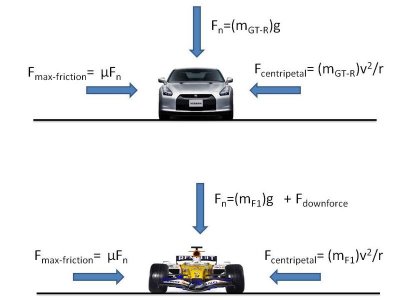A while back an argument was made that the extra weight of the current Nissan GT-R helps it create more grip for cornering whereas a Formula 1 car, being so light, can rely on downforce for creating grip so it can be as light as they want it to be. (For those interested in the thread: http://www.nsxprime.com/forums/showthread.php?t=128804&highlight=nissan+GTr+interview)
I was recently reviewing some old material and I remembered the GT-R argument and decided to have a go at it, so for those interested as well, here is my analysis:
Looking at the force diagram shown here, there are 3 main forces at play while cornering:
Fcentripetal = Centripetal Force (the force that wants to push your car out of the turn)
Ffriction = Friction Force (the force that stops the centripetal force from pushing your car out of the turn)
Fn = Normal Force (The force that pushes your car downwards)
The frictional force (grip) does truly benefit from a heavy car due to its linear relationship to the mass of the car but at the same time the centripetal force also increases by the increase mass of the car. Moreover the centripetal force is quadratically related to velocity so the faster you go into a corner the worst the situation. So in conclusion to that, more weight will create more grip but this gain will be nullified by higher centripetal forces.
The above case is for any car in general. For the case of cars with high aerodynamic downforce (i.e. F1 cars) the disadvantage of heavy weight is even clearer. F1 cars rely on their weight for grip as well as downforce. So the total grip increases dramatically due to the extra component of downforce increasing the normal force and thereby increasing grip. But while this downforce increases grip, unlike weight, it has no effect on the centripetal force at all. So you successfully increase grip while not increasing centripetal force and that is where the power of aerodynamics shine.
So in conclusion, no you don't want more weight on your car for extra cornering grip. But in defense of the GT-R team maybe they hit an odd balance of compromises at exactly the weight they had. Who knows.
Disclaimer:
I in no way post this as a bash thread against the GT-R or against Mr. Kazutoshi Mizuno, both of which I respect greatly. Also everything here is my take on this so I might be totally wrong.
And please if anyone knows how to post the attached picture blown to size in this thread, please do so, I have no idea how to do that myself.
I was recently reviewing some old material and I remembered the GT-R argument and decided to have a go at it, so for those interested as well, here is my analysis:
Looking at the force diagram shown here, there are 3 main forces at play while cornering:
Fcentripetal = Centripetal Force (the force that wants to push your car out of the turn)
Ffriction = Friction Force (the force that stops the centripetal force from pushing your car out of the turn)
Fn = Normal Force (The force that pushes your car downwards)
The frictional force (grip) does truly benefit from a heavy car due to its linear relationship to the mass of the car but at the same time the centripetal force also increases by the increase mass of the car. Moreover the centripetal force is quadratically related to velocity so the faster you go into a corner the worst the situation. So in conclusion to that, more weight will create more grip but this gain will be nullified by higher centripetal forces.
The above case is for any car in general. For the case of cars with high aerodynamic downforce (i.e. F1 cars) the disadvantage of heavy weight is even clearer. F1 cars rely on their weight for grip as well as downforce. So the total grip increases dramatically due to the extra component of downforce increasing the normal force and thereby increasing grip. But while this downforce increases grip, unlike weight, it has no effect on the centripetal force at all. So you successfully increase grip while not increasing centripetal force and that is where the power of aerodynamics shine.
So in conclusion, no you don't want more weight on your car for extra cornering grip. But in defense of the GT-R team maybe they hit an odd balance of compromises at exactly the weight they had. Who knows.
Disclaimer:
I in no way post this as a bash thread against the GT-R or against Mr. Kazutoshi Mizuno, both of which I respect greatly. Also everything here is my take on this so I might be totally wrong.
And please if anyone knows how to post the attached picture blown to size in this thread, please do so, I have no idea how to do that myself.




